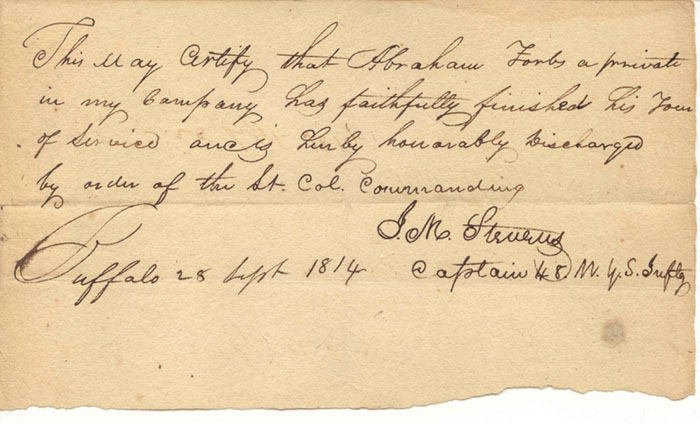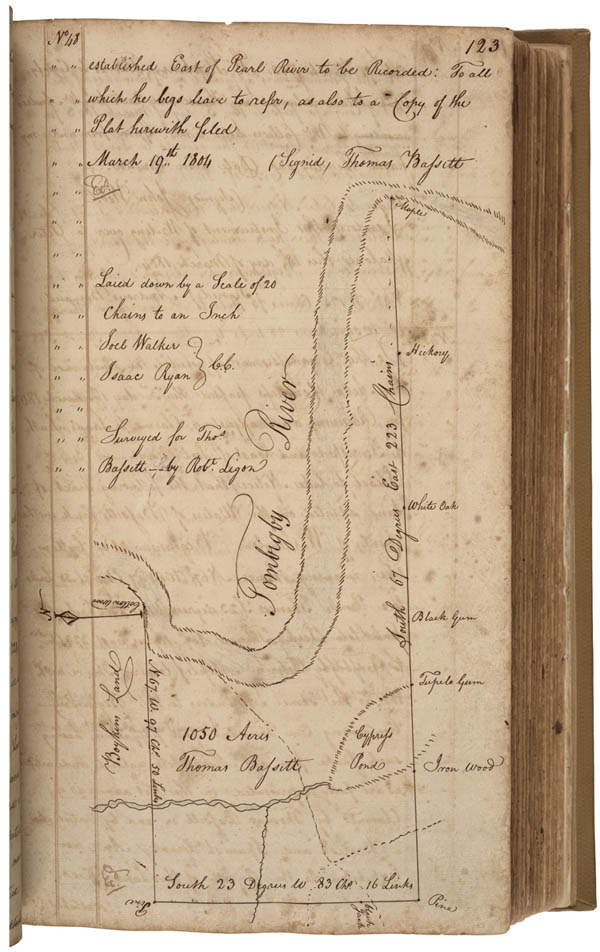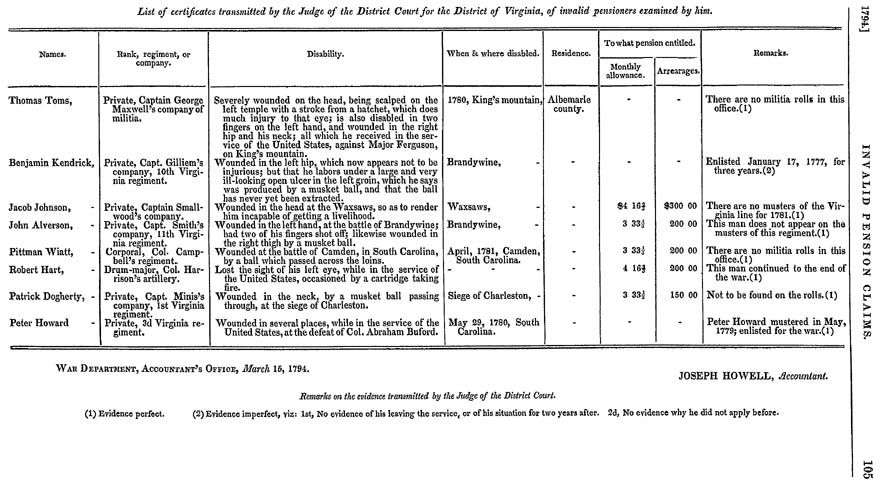
Those Elusive Early Americans:
Public Lands and Claims in the American State Papers, 1789–1837
Summer 2005, Vol. 37, No. 2 | Genealogy Notes
By Chris Naylor
Abraham Forbes served in the United States Army during the War of 1812 and received an honorable discharge. Proof of his service, however, would likely remain a mystery to a researcher who had not consulted congressional records such as the American State Papers, because there is no mention of Forbes in the customary War Department files. Such situations often arise due to inadequate recordkeeping or a lack of documentation surviving from the 18th and early 19th centuries. One widely available, yet largely untapped, resource for genealogical information in this period is the American State Papers.
The American State Papers is a 38-volume published compilation of executive and legislative records dating from 1789 to 1838. In these years, Congress retained a prominent role in settling claims against the federal government. The thousands of claims and other records in the American State Papers preserved from the archives and manuscript records of the Senate and House of Representatives contain a wealth of information on individuals and families living in America during this period. One of these claims appearing in the American State Papers discloses Abraham Forbes's military service.
During the early Congresses, there was no general provision of law to establish guidelines for printing congressional documents. Printing was done unsystematically, with the majority of congressional records located solely in the archives of the two Houses. The burning of the Capitol by the British in 1814 exposed the vulnerability of these documents and heightened the Congress's interest in publishing the records in an organized and accessible form.
In 1817 Congress began distributing the United States Congressional Serial Set. This set of volumes contained reports and documents created by or presented to Congress that it felt needed wider circulation. The U.S. Serial Set was not retroactive and therefore did not contain the records for the first 14 Congresses. Recognizing the importance of preserving and making available to the public the records from the formative years of the country, Congress acted on a proposal by the printers Gales & Seaton and made provision in the following act of March 2, 1831, for that firm to publish executive and legislative writings from the first 13 Congresses:
Be it enacted by the Senate and House of Representatives of the United States of America in Congress assembled, That the clerk of the House of Representatives hereby is authorized and directed to subscribe for 750 copies of the compilation of the Congressional documents proposed to be made by Gales & Seaton: Provided, That the documents shall be selected under the direction of the secretary of the Senate and the clerk of the House: And Provided also, That the price paid for the printing of copies shall be at the rate not exceeding that of the price paid to the printer of Congress for printing the documents of the two Houses.
As a result of the above act (and the subsequent joint resolution of March 2, 1833 and act of June 12, 1858), between 1832 and 1861, Gales & Seaton published 38 volumes. The volumes contain documents covering the years 1789–1838, although not every class has documents from the entire period. The collection is titled the American State Papers and is organized into the following 10 classes or series:
- Foreign Relations
- Indian Affairs
- Finances
- Commerce and Navigation
- Military Affairs
- Naval Affairs
- Post Office Department
- Public Lands
- Claims
- Miscellaneous
While every class can be a valuable resource for genealogists, this article focuses on Class VIII (Public Lands) and Class IX (Claims). The tens of thousands of claims contained in these two classes can provide genealogical information, such as ages of claimants, locations of claims, places of residence, names of spouses, children and other relatives as well as record of the claimants' military service.
Class VIII. Public Lands (1789–1837)
The public domain (public land) is land owned by the federal government that is subject to sale or transfer of ownership under laws passed by Congress. It includes western lands that the original states ceded to the United States as well as acquisitions from foreign governments. Congress was therefore initially responsible for many matters relating to the settlement of land in the public domain. The eight volumes of the Public Lands Class record thousands of diverse land claims and transactions regarding public domain, including military bounty lands, preemption rights, claims by refugees, agreements with Indian Nations, and the settlement of private land claims on public domain that the United States acquired from foreign governments.
Public land states are states that the federal government formed from the public domain. The Public Lands Class deals directly with land claims in these public land states: Alabama, Arkansas, Florida, Illinois, Indiana, Iowa, Louisiana, Michigan, Minnesota, Mississippi, Missouri, Ohio, and Wisconsin.
The original 13 states and Hawaii, Kentucky, Maine, Tennessee, Texas, Vermont, and West Virginia have no public domain. However, several of these states ceded land to Congress for the benefit of the United States. This land then became part of the public domain. The Public Lands Class contains information on these states or their cessions to the United States: Georgia, New York, North Carolina, Pennsylvania, Rhode Island, South Carolina, Tennessee, Vermont, and Virginia.
To successfully claim land located within the public domain, one had to prove right to the land as recognized under public land laws. This meant that the claimant often had to produce evidence or at least explain the basis for the claim. One type of land claim, private land claims on public domain that the United States acquired from foreign governments, often offers researchers a unique opportunity to gain detailed information on the claimants and their families. The British, French, and Spanish governments granted a great deal of land within their American holdings to the inhabitants prior to the acquisition of the territories by the United States. After taking control of the land, the U.S. Government had to validate the titles originally granted by foreign authorities before the claimant could have legal possession of the land.
Although some claims offer little more than name of claimant and location of claim, others, such as Thomas Bassett's claims for two properties along the Tombigbee River in the Mississippi Territory (present-day Alabama), contain detailed information on the claimant and his family. In 1804 Bassett petitioned the "Commissioners appointed in pursuance of the act of Congress, passed the third day of March, 1803, for receiving and adjusting the claims to lands south of Tennessee and east of Pearl river" for rights to these two properties that his family had previously owned under British and Spanish grants. As with many land claims presented before boards of commissioners or other federal agencies, the board forwarded the records to Congress. To prove his case, Bassett submitted notarized depositions, translations of Spanish petitions and titles, surveys, and other documents, which supply information on his family dating back to 1780. This documentation accompanying these two claims builds an interesting portrait of the Bassett family.
In 1780 the Bassett family received from the British Government of West Florida grants for two properties. Indians killed Thomas Bassett, the father of the family, on or near his land in 1781. He was about 37 years old. His wife, Lucy, and two sons, Nathaniel and Thomas, survived. The region came under Spanish control in 1783 as a result of Spain's support for the United States during the American Revolution. In June 1787, the Spanish governor of the territory, Don Stephen Miro, signed and confirmed property and rights to Nathaniel Bassett, son of the late Thomas Bassett. Thomas Bassett, son of the late Thomas Bassett and Nathaniel's brother, was approximately 21 years old in 1787.
In 1788 the Bassett family went to New Orleans to manage business in the area. In their absence, the Bassett family allowed a William Powell to live on a section of their land. Lucy Bassett then suffered a series of accidents. The government seized her property, including the Bassetts' titles to their land, and placed the titles into the public deposit in New Orleans. A fire there in 1794 destroyed the original British and Spanish titles to the two properties.
On July 7, 1800, Nathaniel Bassett wrote to the Spanish government to confirm his title to the land, which had become part of the United States in 1798. By August 4, 1800, Spain had confirmed Nathaniel Bassett's petition. On March 19, 1804, Thomas Bassett, acting as administrator for his late brother, Nathaniel, petitioned the U.S. Government for the rights to his family's lands. The Board of Commissioners confirmed the land to Thomas Bassett, stating that each claim was "supported agreeably to the requirements of the law." Such detail and quantity of family information depicts the true value of the American State Papers to researchers interested in family and social history of the early American period.
Congress also was responsible for the relief of veterans of the Revolutionary War and War of 1812 and passed many acts relating to bounty land, pensions, and other assistance to the soldiers and their families. Congress passed several public acts regulating veterans' claims that established common eligibility requirements and delegated to the secretary of war the responsibility for administering the provisions.
Many veterans and their heirs, however, brought their claims directly to Congress for adjudication, and Congress passed private acts to reward these individuals. Bounty land claims within the Public Lands volumes can supply information about the claimants' military service and subsequent lives. For many veterans of these two wars, the bounty land claims supplement the compiled military service records and pension bounty land files available at the National Archives.
As Abraham Forbes's bounty land claim shows, the American State Papers can be especially valuable in locating information relating to the military service and bounty land records of veterans who do not appear in War Department files. Abraham Forbes does not have a compiled military service record, pension application, or bounty land application at the National Archives, and he is not listed on the army register of enlistments. However, a report from the House of Representatives Committee on Private Land Claims in the American State Papers reveals:
That said Forbes was a citizen of the United States, and removed to Upper Canada prior to the last war; that he joined the troops of the United States, and was employed as a spy, and had the entire confidence of the officers of the United States, and performed many valuable and important services to the United States in that character; that he had been promised a handsome remuneration by Col. Christie, whose premature death perhaps, prevented any communication to the government in behalf of said Forbes; that he acted with the United States troops until the close of the war, and was honorably discharged. . . .
In recognition of these services, Congress ultimately passed a bill granting Forbes 320 acres of land.
After locating a claim in the American State Papers, the researcher can also contact the Center for Legislative Archives at the National Archives for assistance in finding more information on the claim in congressional records. For many of the claims that appear in the American State Papers, there is an original petition and supporting documentation in House and Senate committee files. To contact the Center, write to Center for Legislative Archives, National Archives and Records Administration, 700 Pennsylvania Avenue NW, Washington, DC 20408-0001 (telephone 202-357-5350).
Class IX. Claims (1789–1823)
Congress derives its authority for settling claims against the United States from the first clause of Article 1, section 8, of the Constitution:
The Congress shall have Power To lay and collect Taxes, Duties, Imposts and Excises, to pay the Debts and provide for the common Defence and general Welfare of the United States.
This duty to pay the debts of the United States led Congress to assume many responsibilities in settling or overseeing the adjudication of claims against the United States. The single volume of the Claims class contains a wide array of non–land-related claims from 1789 to 1823, including pensions, property destroyed by the enemy, relief of army contractors, militia claims, compensation for wages, and numerous other unique situations. The assortment of claims in this volume offers researchers a rare glimpse into the daily lives of Americans living at that time.
Congress authorized the Treasury Department to settle many types of claims against the U.S. Government. If the Treasury Department rejected a claim, the claimant's only recourse was to appeal directly to Congress. One example of congressional oversight of the adjudication of claims by the Treasury Department, titled "Claims Barred by the Statutes of Limitations," appears in the Claims volume. On December 13, 1810, the secretary of the treasury sent to the Senate a list of all the claims for which the Treasury Department had adjusted, allowed, and issued certificates of registered debt under an act of March 27, 1792. The act was responsible for "providing for the settlement of the claims of persons under particular circumstances barred by the limitations heretofore established." The list contains the names of almost 1,500 Revolutionary War servicemen along with the date of certificate, statement number, explanation of service, date on which interest commenced, and amount of money issued for each individual.
The Claims volume of the American State Papers proves particularly valuable in the case of pre-1800 Revolutionary War pensions. A fire in the War Department on November 8, 1800, destroyed all Revolutionary War pension and bounty land applications that had been submitted up to that date. Much information on these applicants would have been lost were it not for several War Department reports based on original applications that the secretary of war sent to Congress between 1792 and 1795. The lists for 1792, 1794, and 1795 are printed in the Claims volume and contain name, rank, disability, date and location where disabled, residence, pension entitlement, and other remarks.
Take, for example, Thomas Toms, a private in Capt. George Maxwell's company of militia. There is no compiled military service record for Toms at the National Archives, and most of the information regarding him in Revolutionary War Pension and Bounty Land Warrant Application Files (National Archives Microfilm Publication M804) comes directly from the American State Papers.
His entry on the 1794 list of invalid pensioners for Virginia in the Claims volume states that he lived in Albemarle County, Virginia. He was wounded in 1780 at King's Mountain and claimed a pension relating to the following disability:
Severely wounded on the head, being scalped on the left temple with a stroke from a hatchet, which does much injury to that eye; is also disabled in two fingers on the left hand, and wounded in the right hip and neck; all which he received in the service of the United States, against Major Ferguson, on King's mountain.
The examining physician gave no recommendation for pension entitlement.
Locating and Using the Records
The value of the American State Papers in conducting genealogical research is enhanced by the availability of the records and their ease of use. Although each volume of the American State Papers contains an index, their fragmentary nature has led to the creation of more comprehensive indexes.
In 1972 Phillip W. McMullin created a complete name index to the nine volumes comprising Class VIII (Public Lands) and Class IX (Claims) titled Grassroots of America; A Computerized Index to the American State Papers: Land Grants and Claims 1789–1837 with Other Aids to Research (Salt Lake City: Gendex Corporation, 1972). By listing all the volume and page references for each name entry, the index allows researchers to locate individuals or families throughout the volumes.
The Congressional Information Service (CIS) U.S. Serial Set Index, 1789–1969 (Bethesda, MD: Congressional Information Service, 1975–) also indexes the American State Papers. Although the CIS index is not as comprehensive as Grassroots of America for individual names, it can lead to information in the other classes of the American State Papers or the U.S. Serial Set that is not contained in Classes VIII and IX.
The Library of Congress American Memory web site offers a full-text collection of the American State Papers online at http://memory.loc.gov/ammem/amlaw/lwsp.html, and the table of contents and index for each of the volumes are searchable. Volumes 1–3 of the Public Lands Class that appear on the web site were printed by Duff Green, and the page numbers may not correspond with the Gales & Seaton version.
The thousands of claims in the Public Lands and Claims classes of the American State Papers, complemented by the above-mentioned indexes, provide researchers with a rich resource for locating information on individuals living in America from 1789 to 1837. The American State Papers, Grassroots of America, and the CIS Congressional Masterfile 1, 1789–1969, a CD-ROM containing the CIS U.S. Serial Set Index, are available in the Archives Library Information Center (ALIC) at the National Archives Buildings in Washington D.C., and College Park, Maryland. The American State Papers, various reprints, and other related books are available at libraries around the country.
For more information on researching claims at the National Archives, consult Anne Bruner Eales and Robert M. Kvasnicka, eds., Guide to Genealogical Research in the National Archives of the United States, 3rd ed. (Washington: National Archives and Records Administration, 2000). Chapter 15, Land Records, covers various topics relating to land claims and grants on public domain of the United States. Chapter 16, Claim Records, provides detailed information on researching claims against the U.S. Government at the National Archives.
Chris Naylor is an archives technician in the Research Support Branch of the National Archives and Records Administration, Washington, D.C. He earned B.A. degrees in history and German from the University of Maryland, College Park.


